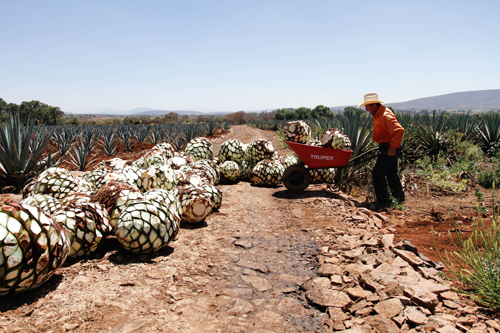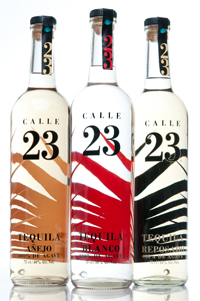A guide to tequila: from bad boy of the bar to a high-end spirit
Tequila is shaking off its image as the bad boy of the bar world and is now perceived as a subtle, high-quality drink embraced by bartenders, says Neil Gerrard
The rhyme "one tequila, two tequila, three tequila, floor" probably tells you all you need to know about the reputation the Mexican spirit once had.
Many British drinkers' first encounter with it a few years ago would have involved "slamming" an inferior version of the drink with a lick of salt and a squeeze of lime to take the taste away as it burned a path through their gullets.
There was also a good chance that it would be one of the final drinks of the evening and, rightly or wrongly, shoulder the blame for the brutal hangover that ensued the next day.
That it should be something of a "bad boy" drink doesn't surprise Carlos Londoño, general manager of London Mexican restaurant Café Pacifico.
But interestingly, tequila's image has been rehabilitated in recent years. Along with the likes of gin and rum, it has enjoyed a rapid resurgence and now finds its way into sophisticated cocktails across the country. In fact, it is the fastest-growing mainstream category in the UK on-trade, with sales up 27% year-on-year in 2015, according to CGA Strategy.
All grown up
So how has it managed to shake off its air of danger? Well, it's possible that it hasn't entirely. But there are various other factors at play and one of them is undoubtedly an improvement in quality and key to that is the blue agave plant.
Tequila is recognised as a Mexican designation of origin product in more than 40 countries, and as such it can only be produced in five states and may only be produced using the heart of the blue agave plant.
Agave can take at least five years to reach maturity, and in the past this has caused problems with anticipating demand. As a result, tequila made with 100% agave wasn't always easy to track down, as Pierre-Charles Cros, the co-founder of the Experimental Cocktail Club, explains: "About 15 years ago production went down and the cost went up like crazy, so 100% agave tequila was hard to find," he says. "There were perhaps only a couple of examples that were around in 2000."
"A bottle could say 'tequila', but only a certain proportion had to be agave - let's say 51% - and the rest could just be molasses or whatever, which made for a very nasty spirit.
"People were not drinking 'real' tequila, but they thought they were. They were drinking a poor-quality spirit that may have made them sick, as other spirits can do, and with a strong taste that they would remember," Cros says.
He argues that the way tequila was marketed was also at fault - it was often billed as that last drink of the night, causing that hangover - not to mention that it could be married with the wrong ingredients in a cocktail.
"I saw a recipe in France for a margarita that involved lemon juice," Cros recalls. "Lemon is not native to Mexico as far as I am aware, and it is a very sour, acidic taste in a margarita. Tequila has a very soft and mellow taste - lime is way more appropriate."
Eventually, improved products made their way to market. LondoÁ±o credits the Mexican government's efforts to have its status as a designation of origin product recognised by as many countries as possible. This was coupled with a more industrial approach to the production of blue agave, which saw plants tended in greenhouses for the first year, making them hardier and likely to grow faster.
Another key driver has been food. For years, Café Pacifico and sister restaurant La Perla Bar and Grill in London's Maiden Lane were the only establishments to fly the flag for Mexican cuisine, but more recently there has been an explosion in its popularity, with multiple brands like Wahaca, Chipotle and Tortilla.
This has no doubt been helped by the fact that Mexican cuisine was inscribed in 2010on the Representative List of the Intangible Cultural Heritage of Humanity by Unesco. And where the food has gone, Mexican biggest drinks exports, such as Corona lager and tequila, have followed.
In the case of the UK, London's reputation as a hub for creative cocktail-making has also helped boost interest in tequila. "Ten years ago, New York was the world's cocktail capital. Where is it now? London," LondoÁ±o asserts.
"Every spirit wants to launch in London because it is the biggest display window. If a bartender loves tequila, they become a communicator. So when a customer says they want a gin and tonic, the bartender may suggest a tequila and tonic or a margarita."
Although it's difficult to quantify, the increase in sales of tequila at Cros' Experimental Cocktail Club venues has been "tremendous". "I think it is going to stay this way because it is a high-quality product and not all the spirits are made with that level of trust," Cros says. "Vodka and rum is a very loose appellation - you can pretty much do it anywhere with anything. Not so with tequila."
Tequila terroir
For LondoÁ±o, one of the drink's other charms is its versatility. Not only does the altitude at which blue agave is grown impart different characteristics, but even the field which it is from can affect the level of sugars (mostly fructose) contained within its heart. The Ocho brand of tequila (see box), with which Café Pacifico is closely associated, names the field in which the agave used to produce it was grown, as well as the year it was made. Each year, and each field, has an effect on the flavour of the drink, LondoÁ±o says. "From a marketing point of view it is great, because it is almost like it has a collectors' feel to it. You may have a favourite field or a favourite year."
So what comes next? Growing in popularity is tequila's even wilder cousin, mescal. "I am a great lover of tequila, but I always tell people that mescal is tequila's daddy," LondoÁ±o says. "Tequila can only be produced in five states with one type of agave. With mescal we are talking about nine states and 30 types of agave. Mescal is wild and crazy and interesting."
And if you want to know just how wild, crazy and interesting, look no further than Scorpion Mezcal, produced by American Doug French, who came up with the idea of placing a cured scorpion in the bottle before filling it with the spirit. Perhaps unsurprisingly, this drink is apparently popular with the US military.
"You have beauty in tequila, but mescal is even more complex. You have more to choose from and it will become more and more popular. For me, it is the Marmite of the agave spirit world and an acquired taste, but one that is a pretty interesting one," LondoÁ±o says.
And you thought tequila had a bad boy image.
How tequila is produced
Blue agave is the base ingredient in tequila. The plant has large, spiky leaves which are cut off to reveal the heart (piÁ±a), which produces a high level of sugars, mostly in the form of fructose. Harvested piÁ±as can weigh anywhere between 40kg and 90kg. The heart is heated to remove the sap, which is then fermented and distilled.
Three of the best
Calle 23 tequila is produced in Zapotlanejo from agaves from the Highland region of Jalisco (fields between Arandas and Tepatitlan), and produced by French-born Sophie Decobecq. There are three different varieties: blanco, reposado and anejo, and they differ according to the type of yeasts used in fermentation and the length of that fermentation. It is particularly goodto mix in cocktails.
UK supplier: Amathus Drinks
Tequila Ocho
Tequila Ocho is made by Carlos Camarena, a third-generation tequilero, in partnership with restaurateur Tomas Estes, the owner of Cafe Pacifico.
The aim of the tequila is to demonstrate that "terroir" exists in agave, and Ocho was reputedly the first tequila to designate the year in which it was produced as well as the precise field from which it was harvested. Each estate, or "rancho", produces a limited amount of agave, and each vintage of Ocho is intended to be both rare and collectable.
UK supplier: Cask Liquid Marketing
Don Fulano
Don Fulano is the legacy of four generations of agave farmers from the Fonseca family, who now craft their tequila at the La Tequilena distillery in the town of Atotonilco. During the 19th century the Fonseca family were integral to the trade of the town and by the 1960s they were supplying many tequila producers throughout the highlands.
In 1973 Don Enrique Fonseca and his eldest son decided to start producing tequila themselves. They bought La TequiliÁ±a distillery from Bacardi & Co in the centre of Tequila, and they produced a number of tequilas using their own premium agave. Don Fulano was founded at the turn of the millennium. The brand produces several types of tequila, including blanco, fuerte, reposado, anejo and imperial.
UK supplier: Speciality brands
Continue reading
You need to be a premium member to view this. Subscribe from just 99p per week.
Already subscribed? Log In








